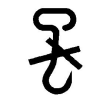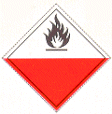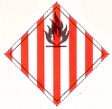| Manila hemp | [German version] |
Table of contents |
|
| General: | ||
| Product information | ||
| Packaging | ||
| Transport | ||
| Container transport | ||
| Cargo securing | ||
Product information
Product name
| German | Manilahanf |
| English | Manila hemp |
| French | Chanvre de Manille |
| Spanish | Cañamo de Manila, abacá |
| Scientific | Musa textilis |
| CN/HS number * | 5305 2ff. |
(* EU Combined Nomenclature/Harmonized System)
Product description
Manila hemp belongs to the category fibers/fibrous materials, which are classified as follows [24]:
Plant hairs:
| Cotton seed-hairs | |
| Kapok tree fruit hairs |
Stalk fibers from dicotyledonous plants (soft fibers):
| Flax, ramie (fine spinnable fibers) | |
| Hemp, jute, kenaf (coarse spinnable fibers) |
Leaf fibers (hard fibers):
| Sisal, Manila hemp, palm fibers (poor spinning characteristics) |
Bast:
| Linden, raffia palm, willow |
Basketwork material:
| Coconut fiber, rattan cane, halfa, piassava, esparto |
Manila hemp is obtained from the abaca, a plant of the banana family (Musaceae), which is also known as the fiber or weaving banana, so explaining the term banana hemp.
Manila hemp is a leaf fiber (hard fiber) obtained from the leaf sheaths of the large banana leaves. These sheaths together form a pseudostem 3 – 4 m in height (see Figures 1 and 2).
Fiber strips up to 8 cm in width („tuxies“) are cut lengthwise from the leaf sheaths, separated from the fleshy parts and dried and bleached in the sun.
Manila hemp is lustrous, yellowish white, 2 – 4 m in length and, like sisal, is a hard fiber. Manila hemp must not be confused with hemp, which is a soft fiber.
It is classified into the following grades on the basis of fineness:
| „Bandala“ is the fiber obtained from the outer, older leaf sheaths of the pseudostem. It is brownish to purple in color. It is a coarse fiber which is preferably converted into tarred ships‘ ropes, nets and other cordage. | |
| „Lupis“ is a somewhat finer fiber. | |
| „Tupoz“ is the light-colored fiber obtained from the inner, younger leaf sheaths. The best qualities are milky white. These are the finest fibers which are converted into nets, ropes, hammocks, furniture coverings, binder twines, cords and hats. | |
| „Tow“ is the fiber waste which is converted into very high quality paper (Manila paper. |
Manila hemp is distinguished by its low weight, tear strength and resistance to weather and water. Its tensile strength is three times that of cotton and twice that of sisal.
Quality / Duration of storage
The quality of Manila hemp, which has poor spinning characteristics, is dependent upon the part of the leaf sheath from which it originates, the manner in which the crude fiber is obtained and upon the timing of and care taken with drying.
Five quality grades are distinguished on the basis of cleanness and color:
| Excellent cleaning | |
| Good cleaning | |
| Fair cleaning | |
| Coarse cleaning | |
| Very coarse cleaning |
Wet, moist or oil-stained bales must be rejected prior to loading because depreciation due to discoloration and mustiness may occur. Manila hemp may absorb up to 30% moisture without feeling moist.
Intended use
Thanks to its resistance to water, Manila hemp is primarily suitable for producing ships‘ ropes and fishing nets. It is also converted into ropes, hammocks, furniture coverings, twine, cords, panama hats, carpets, fine cardboard and high quality paper.
Figure
(Click on the individual Figures to enlarge them.)
 Figure 1 |
 Figure 2 |
Countries of origin
This Table shows only a selection of the most important countries of origin and should not be thought of as exhaustive.
| Europe | Russia |
| Africa | |
| Asia | Philippines (primary country of cultivation), Indonesia |
| America | Central America |
| Australia | Australia |
Back to beginning
Packaging
Manila hemp is transported unpackaged in partially compressed or uncompressed bales weighing approx. 125 kg. The bales are strapped with steel strapping or cane to ensure that they hold together better.
| Marking of packages | ||
 Keep dry |
 Use no hooks |
 Keep away from heat (solar radiation) |
Back to beginning
Transport
Symbols
 Spontaneously combustible, Class 4.2 IMDG Code |
 Fire hazard (Flammable solids), Class 4.1 IMDG Code |
 General cargo |
Means of transport
Ship, truck, railroad
Container transport
Standard containers , subject to compliance with water content of goods, packaging and flooring.
Cargo handling
In damp weather (rain, snow), the cargo must be protected from moisture, since Manila hemp is strongly hygroscopic and readily absorbs moisture. This may lead to discoloration and mustiness.
Do not use hooks for cargo handling, since they may very easily damage the cane. In addition, smoking is absolutely prohibited during cargo handling.
Stowage factor
| 1.42 – 1.81 m3/t (cords in bales) [1] | |
| 1.92 – 1.98 m3/t (twine in bales) [1] | |
| 3.40 – 3.54 m3/t (bales) [1] | |
| 6.13 – 6.97 m3/t (bales, uncompressed) [11] | |
| 2.56 – 2.93 m3/t (bales, compressed) [11] | |
| 1.39 – 1.67 m3/t (bales, highly compressed) [11] | |
| 2.69 – 2.83 m3/t (bales) [14] |
Stowage space requirements
Cool, dry
Segregation
Fiber rope, thin fiber nets.
Care must be taken to ensure proper segregation as the bales contain differing qualities of differing values. Individual batches may, for example, be segregated by different colored marks.
Cargo securing
The cargo is to be secured in such a way that the bales or strapping are not damaged. Undamaged strapping is essential to maintain compression of the bales during transport. If the strapping is broken, compression is diminished, which at the same time results in an increased supply of oxygen to the inside of the bales. This in turn increases the risk of combustion or feeds a fire which has already started.
Back to beginning
Risk factors and loss prevention
RF Temperature
Manila hemp requires particular temperature, humidity/moisture and possibly ventilation conditions (SC VI) (storage climate conditions).
Favorable travel temperature range: no lower limit – 25°C
Manila hemp must be stowed away from heat sources.
Every hold should be equipped with means for measuring temperature. Measurements must be performed and recorded daily.
Back to beginning
RF Humidity/Moisture
Manila hemp requires particular temperature, humidity/moisture and possibly ventilation conditions (SC VI) (storage climate conditions).
| Designation | Humidity/water content | Source |
| Relative humidity | 55% | [1] |
| Water content | 5 – 10% | [1] |
| 12% | [14] | |
| Maximum equilibrium moisture content | 55% | [1] |
Manila hemp behaves strongly hygroscopically (hygroscopicity). It must be protected from sea, rain and condensation water and also from high levels of relative humidity, if discoloration and mustiness are to be avoided.
Manila hemp may increase its water content to 30% without feeling damp. For this reason, moisture levels should be measured when a consignment is accepted. Moisture-damaged bales must not be accepted.
Back to beginning
RF Ventilation
Manila hemp requires particular temperature, humidity/moisture and possibly ventilation conditions (SC VI) (storage climate conditions).
If the product is loaded for shipment in a dry state, it does not have any particular ventilation requirements.
Problems arise if the product, packaging and/or ceiling/flooring are too damp. In this case, the following ventilation measures should be implemented:
Air exchange rate: 10 – 20 changes/hour (airing)
Since Manila hemp very readily absorbs oxygen, before anybody enters the hold, it must be ventilated and if necessary a gas measurement carried out, since a shortage of oxygen may endanger life.
Back to beginning
RF Biotic activity
Manila hemp displays 3rd order biotic activity.
It belongs to the class of goods in which respiration processes are suspended, but in which biochemical, microbial and other decomposition processes still proceed.
Back to beginning
RF Gases
Manila hemp very readily absorbs oxygen. An oxygen shortage may therefore arise in closed holds and containers. Before anybody enters such holds, the holds must be ventilated and, if necessary, a gas measurement carried out.
The increase in CO2 and CO content indicates a cargo fire. The TLV of the hold air is 0.49 vol.%.
Back to beginning
RF Self-heating / Spontaneous combustion
Manila hemp has an oil content of 6.0 – 8.7% (waxes).
Manila hemp is assigned to Class 4.1 of the IMDG Code (Flammable solids). However, its specific characteristics and negative external influences (see below) may cause it to behave like a substance from Class 4.2 (Substances liable to spontaneous combustion) of the IMDG Code or ADR.
Manila hemp must always be protected from sparks, fire, naked lights and lit cigarettes. Smoking is absolutely prohibited. In accordance with the IMDG Code, ventilation openings leading into the hold should be provided with spark-proof wire cloth.
Spontaneous combustion may occur as a result of exposure to moisture, animal and vegetable fats/oils, oil-bearing seeds/fruits, copra and raw wool.
Fire-fighting is best performed using CO2 . When fighting a fire, do not break the cane or open the bales, since relieving the compression increases the oxygen supply and makes it impossible to fight the fire effectively.
Water must not be used for fire-fighting, since the swelling capacity of the Manila hemp may cause damage to the hold or container walls.
Back to beginning
RF Odor
| Active behavior | Manila hemp has a slight, unpleasant odor. A conspicuous musty odor indicates moisture damage. |
| Passive behavior | Manila hemp is sensitive to unpleasant or pungent odors. |
Back to beginning
RF Contamination
| Active behavior | Manila hemp does not cause contamination. |
| Passive behavior | Manila hemp is sensitive to contamination by dust, dirt, fats/oils and rust as well as oil-containing goods, such as oil-bearing seeds/fruits, copra, raw wool etc., since oil-impregnated fibers promote self-heating/cargo fire. Holds or containers must accordingly be clean and in a thoroughly hygienic condition. Residues from previous cargoes, such as ores, stones, coal, metal filings, fertilizers etc., result in losses. |
Back to beginning
RF Mechanical influences
Care must be taken to ensure that mechanical influences do not cause damage to strapping, which increases the risk of fire by relieving the compression of the bales and allowing a greater supply of oxygen.
Back to beginning
RF Toxicity / Hazards to health
Since Manila hemp is highly oxygen-absorbent, a life-threatening shortage of oxygen may arise in the hold or container. Thus, before anybody enters the hold, it must be ventilated and, if necessary, a gas measurement carried out. The TLV for CO2 concentration is 0.49 vol.%.
Back to beginning
RF Shrinkage/Shortage
Unclearly marked bales may result in losses of volume due to incorrect delivery.
Back to beginning
RF Insect infestation / Diseases
No risk.
Back to beginning
